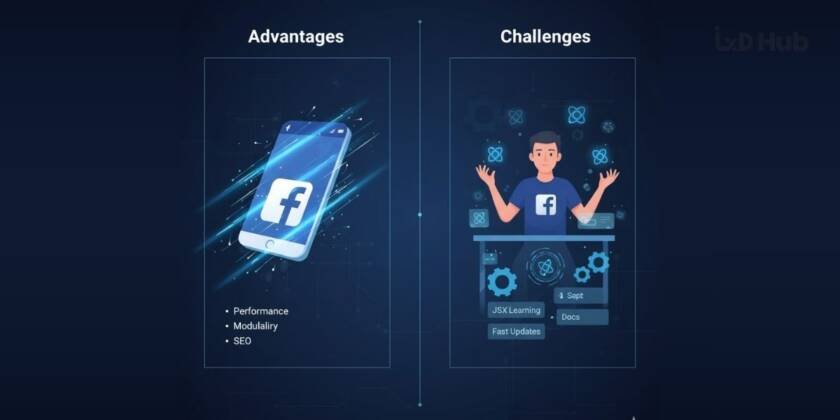In the late 2000s, a senior front-end engineer at Facebook faced an endless nightmare: every time users interacted with the feed — liked, commented, or posted — the entire page had to reload or be manually updated. It was slow, buggy, and maddening.
To solve this, Facebook’s team built something revolutionary — a way to update only the parts of a page that changed, not the whole thing. That internal experiment became React JS, and it quietly changed the web forever.
Fast-forward to today: React powers everything from Netflix and Airbnb to Instagram and Uber Eats. What started as a tool for fixing a laggy newsfeed became the heartbeat of modern front-end development.
React JS isn’t just popular — it’s the foundation of the interactive internet.
Its dominance isn’t about hype; it’s about a new mental model for building digital products.
Instead of patching together static HTML, CSS, and jQuery, React taught developers to think in components, to reuse logic, and to update interfaces instantly.
The result? Apps that feel as fast as native software — and teams that ship twice as fast.
1. What Is React JS — and Why Developers Swear by It

At its core, React JS is a declarative, component-based JavaScript library for building user interfaces.
It’s not a full framework like Angular or Vue — it focuses purely on the “View” layer in the Model-View-Controller (MVC) pattern.
Here’s why that distinction matters:
-
Flexibility: React doesn’t dictate how to build your app. You choose your tools for routing, APIs, or state management.
-
JSX: React uses JavaScript XML (JSX), a syntax that blends logic and layout in one file — clean, readable, and powerful.
-
Declarative UI: You tell React what the UI should look like for a given state, and it takes care of updating the DOM efficiently.
2. The Secret Sauce: Why React Became Unstoppable

| Key Popularity Driver | Expert Insight |
|---|---|
| Virtual DOM (VDOM) | React’s innovation — it builds a lightweight copy of the DOM and updates only the changed parts. The result: faster apps and smoother user experiences. |
| Component-Based Architecture | Everything — from buttons to dashboards — is a reusable component. This modularity means faster development, easier testing, and better scalability. |
| Backed by Meta (Facebook) | Continuous innovation, long-term stability, and massive community support give businesses confidence to invest in React. |
| “Learn Once, Write Anywhere” | React’s model powers both web (React JS) and mobile (React Native), saving teams months of development time. |
| Rich Ecosystem | From Redux to Next.js, React’s ecosystem is unmatched — whatever you need, there’s a React solution for it. |
3. Advantages and Disadvantages (From a Veteran’s View)

Key Advantages
| Advantage | Business Benefit |
|---|---|
| High Performance via Virtual DOM | Faster apps lead to better user retention and improved SEO. |
| Reusable & Testable Components | Less development time, fewer bugs, and lower long-term costs. |
| Unidirectional Data Flow | Predictable state management, even in large applications. |
| SEO Friendliness (with SSR) | Tools like Next.js or Remix enable server-side rendering for faster, SEO-optimized pages. |
Key Disadvantages (and How Experts Overcome Them)
| Disadvantage | Expert Solution |
|---|---|
| Fast-Paced Ecosystem | Focus on React’s core — components, hooks, state — and use frameworks like Next.js to simplify configuration. |
| View-Layer Only Limitation | Use React Router for navigation and Redux or Zustand for global state. |
| Documentation Lag | Stick to official docs first; supplement with high-rated community guides. |
| JSX Learning Curve | Remember: JSX compiles to JavaScript. The long-term gain in clarity is worth the early confusion. |
4. Best Use Cases — Where React Truly Shines
| Business Model / Application | Why React Excels | Famous Examples |
|---|---|---|
| Social Platforms | Real-time feeds, instant updates, dynamic UIs. | Facebook, Instagram, X (Twitter) |
| E-commerce | Fast, interactive product filters, smooth checkout. | Walmart, Airbnb, Salesforce |
| SaaS Dashboards | Handles real-time data visualizations effortlessly. | Asana, Jira, Dropbox |
| Streaming & Media Apps | Lightning-fast load times and responsive layouts. | Netflix, BBC, New York Times |
| Cross-Platform Mobile Apps | Shared codebase for iOS and Android. | WhatsApp, Uber Eats, Instagram |
5. Common Pain Points — and Expert Fixes
| Pain Point | The Veteran’s Fix |
|---|---|
| Prop Drilling | Use Context API or Redux to share state globally without passing props down manually. |
| Wasted Re-renders | Use React.memo() and useCallback() to prevent unnecessary rendering. |
| Mixed Logic and UI | Move business logic to custom hooks for cleaner, testable components. |
| SEO Limitations | Implement Server-Side Rendering with Next.js to pre-render pages for crawlers. |
| Complex Architecture | Define folder structures and naming conventions early. Use TypeScript for maintainability. |
React isn’t just another front-end tool — it’s the language of modern digital experience.
If you’re building something meant to scale, perform, and delight — React isn’t optional; it’s essential.
Ready to Build a Scalable React Website?
You don’t have to navigate React’s complexity alone.
At IxD Hub, we help businesses design and build high-performance React JS applications that are fast, SEO-optimized, and future-ready.Let’s turn your idea into a React-powered reality.
Contact Us — Fill out a quick form, and we’ll help you map out a React strategy that fits your business.
Chat on WhatsApp — Talk directly with our experts for a no-obligation consultation.
FAQs — React JS Explained by Experts
1. What makes React JS different from other frameworks?
React focuses purely on the UI layer and uses a Virtual DOM for faster updates. Its modular structure and reusable components make it flexible and highly efficient.
2. Is React JS good for SEO?
By default, React is client-side, but frameworks like Next.js enable server-side rendering (SSR), making React apps SEO-friendly.
3. How long does it take to build a React-based web app?
A simple React app can be built in weeks, but larger, feature-rich applications (e.g., e-commerce or dashboards) can take 3–6 months, depending on complexity.
4. Can I use React for mobile app development?
Yes. React Native allows developers to use the same React principles to build native mobile apps for iOS and Android.
5. Is React still relevant in 2025?
Absolutely. With React Server Components, Next.js 14, and a growing ecosystem, React continues to dominate modern web and mobile app development.




